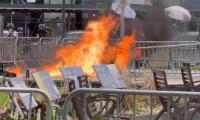Finance Minister Ishaq Dar wants us to celebrate Pakistan’s ‘growth story’ since, according to him, ‘the world is celebrating it’. The size of Pakistan’s economy has reached $300 billion; the federal budget’s size has also touched a new peak, reaching Rs5 trillion.
Modern economies are not just based on the size of their population, but also on the changing socio-economic base of their societies. The key question is: have we transformed the traditional, agro-economy into a modern industrial economy? Has the PML-N laid down the foundation for such an economy?
For those of us who have been following Pakistan’s budget for years, its basic structure and composition does not change. The Sharif-Dar managed economy lifted us out of circular debt back in 2013. But we stand – four years down the road – in the same place. The prime minister has ordered an inquiry into the mounting Rs400 billion circular debt.
Despite spending Rs2.5 trillion on development since 2013, the PML-N government has failed to end the power crisis in country. The Diamer-Bhasha Dam, which was inaugurated by Gen Musharraf over a decade ago, is still in the process of construction. The speed of the construction and pace of financial allocation suggest it will take ages for the dam to be completed. The dam could help provide cheaper electricity.
It is interesting to note that Nawaz Sharif and Musharraf, both, have keenly lobbied for big dams, but once approval was granted for the dam, both showed little interest in its construction. In the current fiscal year, a meagre amount of Rs21 billion, out of a total of Rs127 billion for the power sector, was allocated for this dam.
It may be noted that all big dams in the country’s history were built with international financial support, but there has not been much interest from international funding institutions and banks in providing support for this dam. The dam would be a major source of clean and renewable energy for the country. Pakistan is ahead of India and the US in producing clean energy. But the current government seems more focused on coal and LNG-generated power.
The federal government, in its budget papers, should talk about its resources from the federation. After revenue transfer to the provinces under the NFC, the federal government’s net revenue will be Rs2.9 trillion. Out of this, over one trillion will be spent on the defence of the country (including pensions of army men, which was excluded from the defence budget during Pervez Musharraf’s rule) and Rs1.36 trillion on debt-servicing. The government is left with hardly Rs500 billion to run the affairs of the state. There is an ambitious target of spending Rs1 trillion on development, a 40 percent increase compared to last year.
The dream of Pakistan becoming an Asian Tiger won’t be fulfilled unless the economy is modernised, and industrialisation and technology become its strong base. The modern economy is witnessing major shifts and is now a combination of technology and knowledge economy. Forbes magazine issued a list of the world’s 25 most innovative companies which are using technology and innovation to increase their market share.
Asian Tigers – South Korea, Malaysia, or for that matter China – would not have grown into big economies had there been no massive foreign investment, creating a huge export base. We all know China received high capital inflows from Hong Kong, Taiwan, the US and European countries. Billions of dollars were injected into the East Asian economies too and only then were their economies and societies modernised. Pakistan, with $2 billion investment won’t go much far. The modern miracles of East Asia and Far East Asia were based on export-led growth. In contrast, our exports were first stagnant, and have now declined.
The PML-N draws its political power from Punjab. Without popular support from the other three provinces, it needed to be extremely cautious in its distribution of the federal development budget of over a trillion rupees. However, as was feared, the party continued past practices and ignored the smaller provinces. It plans to spend only 2.7 percent in Sindh. The Sindh government, instead of making a statement of protest, accepted it as a norm. It is yet to be seen how the MQM and PTI, who have votes in Sindh, react to this stark discrimination.
For Ishaq Dar, Pakistan’s economy might be shining, but all citizens know and experience inequality. We see deprivation and mass poverty around us. In a country where most people do not have access to drinking water, how can the federal government spent Rs840 million for the airport security force – including an officers’ mess in Karachi amounting to Rs600 million. We will continue to build such officers’ messes and airports in a country that is 40 percent poor. Their hearts don’t feel the pain of the deprived, and their development priorities seem to be written in stone. A hundred deaths were reported in Thar; PM Nawaz Sharif paid a ceremonial visit, but not a penny for the people of Thar.
We know the federal government does not transfer development funds to the province;, it carries out its allocated fund through its own ministries. Sindh is part of the federation. It is unjust to treat the federating units unequally. That only widens provincial imbalance and helps create disparity – which politicians end up exploiting. It is important to question such unjustified distribution of federal resources.
Email: mush.rajpar@gmail.com







